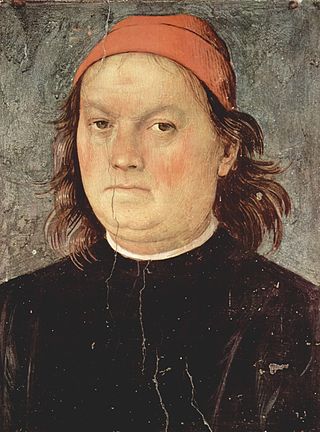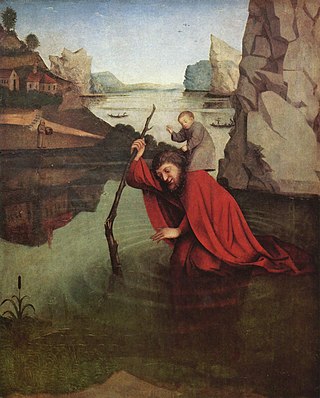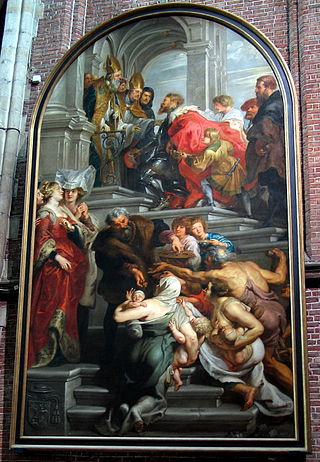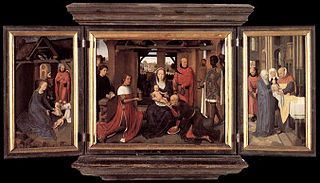
Fra Angelico, OP was a Dominican friar and Italian painter of the Early Renaissance, described by Giorgio Vasari in his Lives of the Artists as having "a rare and perfect talent". He earned his reputation primarily for the series of frescoes he made for his own friary, San Marco, in Florence, then worked in Rome and other cities. All his known work is of religious subjects.

An altarpiece is an artwork such as a painting, sculpture or relief representing a religious subject made for placing at the back of or behind the altar of a Christian church. Though most commonly used for a single work of art such as a painting or sculpture, or a set of them, the word can also be used of the whole ensemble behind an altar, otherwise known as a reredos, including what is often an elaborate frame for the central image or images. Altarpieces were one of the most important products of Christian art especially from the late Middle Ages to the era of the Counter-Reformation.

A triptych is a work of art that is divided into three sections, or three carved panels that are hinged together and can be folded shut or displayed open. It is therefore a type of polyptych, the term for all multi-panel works. The middle panel is typically the largest and it is flanked by two smaller related works, although there are triptychs of equal-sized panels. The form can also be used for pendant jewelry.

A polyptych is a painting which is divided into sections, or panels. Specifically, a "diptych" is a two-part work of art; a "triptych" is a three-part work; a tetraptych or quadriptych has four parts, whereas a polyptych describes any work of art formed of more than one constitutive part.

Lorenzo Lotto was an Italian painter, draughtsman, and illustrator, traditionally placed in the Venetian school, though much of his career was spent in other north Italian cities. He painted mainly altarpieces, religious subjects and portraits. He was active during the High Renaissance and the first half of the Mannerist period, but his work maintained a generally similar High Renaissance style throughout his career, although his nervous and eccentric posings and distortions represented a transitional stage to the Florentine and Roman Mannerists.

Pietro Perugino, born Pietro Vannucci, was an Italian Renaissance painter of the Umbrian school, who developed some of the qualities that found classic expression in the High Renaissance. Raphael was his most famous pupil.

Alessandro Bonvicino, more commonly known as Moretto, or in Italian Il Moretto da Brescia, was an Italian Renaissance painter from Brescia, where he also mostly worked. His dated works span the period from 1524 to 1554, but he was already described as a master in 1516. He was mainly a painter of altarpieces that tend towards sedateness, mostly for churches in and around Brescia, but also in Bergamo, Milan, Verona, and Asola; many remain in the churches they were painted for. Most are on canvas, but a number even of large ones are on wood panel. Only a handful of drawings survive.

Konrad Witz was a painter, active mainly in Basel.

The Altarpiece by Veit Stoss, also St. Mary's Altar, is a large Gothic altarpiece and a national treasure of Poland. It is located behind the high altar of St. Mary's Basilica in the city of Kraków. The altarpiece was carved between 1477 and 1489 by the German-born sculptor Veit Stoss who lived and worked in the city for over 20 years.

San Martino ai Monti, officially known as Santi Silvestro e Martino ai Monti, is a minor basilica in Rome, Italy, in the Rione Monti neighbourhood. It is located near the edge of the Parco del Colle Oppio, near the corner of Via Equizia and Viale del Monte Oppio, about five to six blocks south of Santa Maria Maggiore.

The Palau Reial Major is a complex of historic buildings located in Plaça del Rei, Barcelona, Catalonia, Spain. It was a residence of the counts of Barcelona and kings of Aragon. It is composed of three distinct edifices:

Püha is a village in Saaremaa Parish, Saare County in western Estonia.

The San Giobbe Altarpiece is a c. 1487 oil painting by the Italian Renaissance master Giovanni Bellini. Inspired by a plague outbreak in 1485, this sacra conversazione painting is unique in that it was designed in situ with the surrounding architecture of the church, and was one of the largest sacra conversazione paintings at the time. Although it was originally located in the Church of San Giobbe, Venice, it is now housed in the Gallerie dell'Accademia in Venice after having been stolen by Napoleon Bonaparte.
Events from the year 1652 in Denmark.

The St John Altarpiece is a large oil-on-oak hinged-triptych altarpiece completed around 1479 by the Early Netherlandish master painter Hans Memling. It was commissioned in the mid-1470s in Bruges for the Old St. John's Hospital (Sint-Janshospitaal) during the building of a new apse. It is signed and dated 1479 on the original frame – its date of installation – and is today still at the hospital in the Memling museum.

The Conversion of Saint Bavo is an altarpiece by Peter Paul Rubens, dated 1623–1624. It was commissioned as the high altarpiece for Sint-Baafskathedraal in Ghent by bishop Antoon Triest (1577–1657). It is still sited in the cathedral. An oil sketch for it is now in the National Gallery, London.

Crucifixion with the Virgin Mary, St John and St Mary Magdalene is a painting by Anthony van Dyck. He produced it in 1617-19 as the high altarpiece for the Jesuit church in Bergues, near Dunkirk, during his time as an assistant painter to Peter Paul Rubens - for a long time the painting was even attributed to Rubens. It was paid to Rubens in 1621 and seems to have been sold around 1746. It was bought by Louis XV of France in Antwerp in 1749 to be the high altarpiece of Saint-Louis de Versailles at the Palace of Versailles. It is now in the Louvre, in Paris.

The Sant'Agostino Altarpiece is a painting by Perugino, produced in two stages between around 1502 and 1512 and then around 1513 to 1523. The altarpiece's 28, 29 or 30 panels were split up during the Napoleonic suppression of religious houses - most of its panels are now in the Galleria Nazionale dell'Umbria in Perugia. It is notable as the painter's last masterwork before he moved into his late phase producing more provincial commissions.

The Santo Domingo el Antiguo Altarpiece is a 1577-1579 altarpiece by El Greco, painted for the Monastery of Santo Domingo el Antiguo in Toledo, Spain. The artist had just arrived in Spain and this was his first major commission there, gained thanks to Diego de Castilla, who he had met in Rome.

The Jan Floreins Altarpiece or Triptych of Jan Floreins is a 1479 three-panel altarpiece, painted by Hans Memling for brother Jan Floreins of the Oud Sint-Janshospitaal in Bruges, where it still hangs as part of the collection of the Memlingmuseum.





















